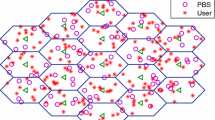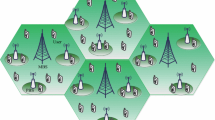Abstract
In mobile telecommunications operation, radio channels are scarce resources and should be carefully assigned. One possibility is to deploy the hierarchical cellular network (HCN). This paper studies a HCN channel assignment scheme called repacking on demand (RoD). RoD was originally proposed for wireless local loop networks. We expend this work to accommodate mobile HCN. A simulation model is proposed to study the performance of HCN with RoD and some previously proposed schemes. Our study quantitatively indicates that RoD may significantly outperform the previous proposed schemes.
Similar content being viewed by others
References
R. Beraldi, S. Marano and C. Mastroianni, A reversible heirarchical scheme for microcellular systems with overlaying macrocells, in: Proc. of IEEE Infocom (1996) pp. 51–58.
L.J. Cimini, G.J. Foschini, C.-L.I and Z. Miljanic, Call blocking performance of distributed algorithms for dynamic channel allocation in microcells, IEEE Tran. on Comm. 42(8) (1994) 2600–2607.
B.O.P. Gudmundson, (Sollentuna, SE), H. Eriksson, (Vallentuna, SE) and O.E. Grumlund, (Kista, SE), Method of effecting handover in a mobile multilayer cellular radio system. U.S. Patent (1995).
C.-J. Ho, C.-T. Lea and G.L. Stuber, Call admission control in the microcell/macrocell overlaying system. IEEE Tran. on Vehicular Tech. 50(4)(2001) 992–1003.
H. Holma and A. Toskala, WCDMA for UMTS (John Wiley & Sons, 2000).
H.-N. Hung, Y.-B. Lin, N.-F. Peng and H.-M. Tsai, Repacking on demand in two-tier WLL. Accepted and to appear in IEEE Transactions on Wireless Communications.
C.-L. I, L.J. Greenstein and R.D. Gitlin, A microcell/macrocell cellular architecture for low- and high-mobility wireless users. IEEE JSAC 11(6) (1993) 885–891.
B. Jabbari and W.F. Fuhrmann, Teletraffic modeling and analysis of flexible heirachical cellular networks with speed-sensitive handover strategy. IEEE JSAC 15(8) (1997) 1539–1548.
F.P. Kelly, Reversibility and Stochastic Networks (John Wiley & Sons Ltd., 1979).
L. Kleinrock, Queueing Systems; Vol. I: Theory (Wiley, 1975).
X. Lagrange, Multitier cell design, IEEE Communications Magazine 35(8) (1997) 60–64.
Y.-B. Lin and V.W. Mak, Eliminating the boundary effect of a large-scale personal communication service network simulation, ACM Tran. on Modeling and Computer Simulation 4(2) (1994) 165–190.
Y.-B. Lin, W.-R. Lai and R.J. Chen, Performance analysis for dual band PCS networks. IEEE Tran. on Computers 49(2) (2000) 148–159.
K. Maheshwari and A. Kumar, Performance analysis of microcellization for supporting two mobility classes in cellular wireless networks. IEEE Tran. on Vehicular Tech. 49(2) (2000) 321–333.
P.A. Ramsdale, (Walden, GB) and P.S. Gaskell, (Shelford, GB), Handover techniques. U.S. Patent (1994).
S.S. Rappaport and L.-R. Hu, Microcellular communication systems with hierarchical macrocell overlays: Traffic performance models and analysis, in: Proceedings of the IEEE 82(9) (1994) 1383–1397.
R. Steele, M. Nofal and S. Eldolil, Adaptive algorithm for variable teletraffic demand in highway microcells. Electronics Letters 26(14) (1990) 988–990.
F. Valois and V. Veque, Preemption policy for hierarchical cellular network. In: 5th IEEE Workshop on Mobile Multimedia Communication (1998) pp. 75–81.
F. Valois and V. Veque, QoS-oriented channel assignment strategy for hierarchical cellular networks. IEEE PIMRC 2 (2000) 1599–1603.
L.-C. Wang, G.L. Stuber and C.-T. Lea, Architecture design, frequency planning, and performance analysis for a microcel/macrocell overlaying system. IEEE Tran. on Vehicular Tech. 46(4) (1997) 836–848.
P.A. Whiting and D.W. McMillan, Modeling for repacking in cellular radio, in: 7th U.K. Teletraffic Symp. (1990).
Author information
Authors and Affiliations
Corresponding author
Additional information
Hsien-Ming Tsai was born in Tainan, Taiwan, R.O.C., in 1973. He received the double B.S. degrees in Computer Science & Information Engineering (CSIE) and Communication Engineering, the M.S. degree in CSIE, and the Ph.D. degree in CSIE from National Chiao-Tung University (NCTU), Taiwan, in 1996, 1997, and 2002, respectively. He is currently a research specialist in Quanta Research Institute, Quanta Computer Inc. His research interests are in the areas of cellular protocols (UMTS/GPRS/GSM/DECT), cellular multimedia (MPEG-4 Audio/Speech), and embedded systems. He is an IEEE member.
Ai-Chun Pang was born in Hsinchu, Taiwan, R.O.C., in 1973. She received the B.S., M.S. and Ph.D. degrees in Computer Science and Information Engineering from National Chiao Tung University (NCTU) in 1996, 1998 and 2002, respectively. She joined the Department of Computer Science and Information Engineering, National Taiwan University (NTU), Taipei, Taiwan, as an Assistant Professor in 2002. Her research interests include design and analysis of personal communications services network, mobile computing, voice over IP and performance modeling.
Yung-Chun Lin was born in Kaohsiung, Taiwan, R.O.C., in 1978. He received the B.S. and M.S. degrees in Computer Science and Information Engineering (CSIE) from National Chiao-Tung University (NCTU), Taiwan, in 2001, 2003, respectively. He is currently pursuing the Ph.D. degree in CSIE. His research interests include design and analysis of a personal communications services network, the cellular protocols (UMTS/GPRS/GSM), and mobile computing.
Yi-Bing Lin received his BSEE degree from National Cheng Kung University in 1983, and his Ph.D. degree in Computer Science from the University of Washington in 1990. From 1990 to 1995, he was with the Applied Research Area at Bell Communications Research (Bellcore), Morristown, NJ. In 1995, he was appointed as a professor of Department of Computer Science and Information Engineering (CSIE), National Chiao Tung University (NCTU). In 1996, he was appointed as Deputy Director of Microelectronics and Information Systems Research Center, NCTU. During 1997-1999, he was elected as Chairman of CSIE, NCTU. His current research interests include design and analysis of personal communications services network, mobile computing, distributed simulation, and performance modeling. Dr. Lin has published over 150 journal articles and more than 200 conference papers. Lin is an Adjunct Research Fellow of Academia Sinica, and is Chair Professor of Providence University. Lin serves as consultant of many telecommunications companies including FarEasTone and Chung Hwa Telecom. Lin is an IEEE Fellow and an ACM Fellow.
Rights and permissions
About this article
Cite this article
Tsai, HM., Pang, AC., Lin, YC. et al. Repacking on Demand for Hierarchical Cellular Networks. Wireless Netw 11, 719–728 (2005). https://doi.org/10.1007/s11276-005-3526-5
Issue Date:
DOI: https://doi.org/10.1007/s11276-005-3526-5




